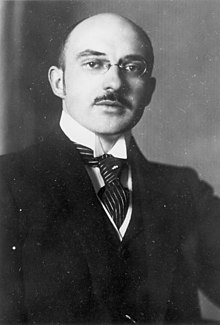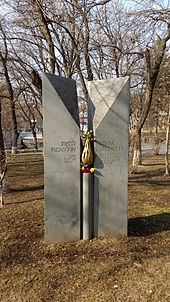Armenian genocide and the Holocaust
[12] It happened during World War I, and it was carried out by the Turkish Regime and the Committee of Union and Progress; CUP, which included the Ottoman Empire and The Republic of Turkey.
The targeting of the Jewish community was due to the economic and political crisis that arose after Germany lost World War I (Intro to the Holocaust).
"[17] According to historians Dominik J. Schaller and Jürgen Zimmerer [de], it is widely believed that there is a causal relationship between the Armenian genocide and the Holocaust.
[22] Omer Bartov, Eldad Ben Aharon and Tessa Hofmann all believe that at least to some extent, the Nazis were inspired by the Armenian genocide.
During a 1939 speech, Hitler was quoted as saying: I have placed my death-head formation in readiness – for the present only in the East – with orders to them to send to death mercilessly and without compassion, men, women, and children of Polish derivation and language.
[27][28] According to Hannibal Travis, "Chamberlain, Hess, Rosenberg, Seeckt, Scheubner-Richter, and von Papen all likely played a role in prompting Hitler to use Turkey's example as a model for Poland.
[30] Historians such as Ihrig and Jersak have emphasized that the Nazis would have[clarification needed] concluded that genocide could be camouflaged under the guise of war and would go unpunished.
For example, a February 1939 Sopade report by the German resistance stated: At this moment in Germany the unstoppable extermination of a minority is taking place by way of the brutal means of murder, of torment to the degree of absurdity, of plunder, of assault, and of starvation.
[40][41] According to Tessa Hofmann, Hitler was fascinated by the figure of Mustafa Kemal Atatürk and would have considered the Armenians as the loser nation that "deserved their doom".
[42] Turkey's policy under the leadership of Atatürk until 1938 and İnönü until 1950, remained sympathetic towards Nazi Germany prior to the end of World War II.
In East Thrace, Kemalist Turkey organized pogroms targeting Jews starting from the 30s, labeling them "bloodsuckers of the Turks" under the leadership of İbrahim Tali Öngören.
[The Jews] constitute this secret danger and may perhaps, through their workers' clubs, seek to establish communist nuclei in our country; that is why it is an absolute necessity [...] to finally and in the most radical way solve the [Jewish] problem.
[43] Also in 1941, İnönü refused to allow the Struma, a Romanian boat with over 770 Jewish refugees,[44] to dock in Turkey, and forcefully sent it back into the sea, where it was subsequently sunk by a Soviet submarine[43] leaving only one survivor, David Stoliar.
[48]There are many similarities between the Armenian genocide and the Holocaust, such as a world war, the attempted destruction of members of an ethnoreligious community which had previously been citizens of the polity,[17] deportation in trains and the role of racism and religious prejudice.
[49] Historian Hans-Lukas Kieser states, "In both cases, young imperial elites and would-be saviors of empires had traumatically witnessed the loss of power, prestige, territory, and homes.
In an unstable political situation and fearing imperial and personal ruin, they succeeded in establishing a single-party regime that allowed them to implement policies of expulsion and extermination based on crazy, but calculated social Darwinist engineering.
Law professor Uladzislau Belavusau criticized this decision for "creat[ing] a speculative distinction between the Holocaust and other 20th-century atrocities" that amounted to trivialization of the Armenian genocide.
"So Holocaust denial is now banned on FB, according to Zuckerberg, but those who deny the Armenian Genocide are very welcome on Facebook—and even rewarded by having their targets' pages blocked," said Kasparov.
The person who is denying would be “subject to up to one year of imprisonment and or have to pay a fine of €45,000”[61] (France’s Draft Law on the Armenian Genocide:).
Additionally, the Entente powers of Great Britain, France, and Russia deemed in May 1915, during World War I “condemned the Ottoman Turkish government’s mass killing of its Armenian population in eastern Anatolia by referring to “new crimes… against humanity and civilization.”[62] (Crimes Against Humanity and the Development of International Law | The National WWII Museum | New Orleans).





